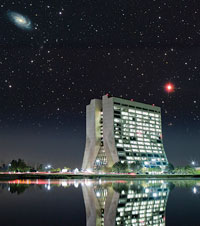Physics in a cornfield
On a cool September evening in a cornfield south of Chicago, dozens of telescopes turned skyward for one of the largest star parties in the Midwest. At the center, Fermilab astrophysicist Dan Hooper was describing something no telescope can see.
 |
| Photo illustration: Reidar Hahn, Fermilab |
As keynote speaker for “Astrofest 2010: The Link between Particle Physics and Astronomy,” Hooper explained physicists' pursuit of the invisible dark matter and dark energy that make up most of the universe.
“If we want to understand the universe at the largest scales, we have to understand the laws of physics at the smallest scales,” Hooper said. “We can tell by looking at galaxies that the part of the universe made of atoms is only a very small fraction of it. Dark matter and dark energy make up 95 percent of the universe, but we still don't know what they are.”
Astronomers and particle physicists have joined forces to explore the universe's dark side. “In recent decades, these two seemingly different fields have become very interconnected,” Hooper says.
The connection spurred the Chicago Astronomical Society to focus for the first time on particle physics during its yearly Astrofest star party. Founded in 1862, the society is the oldest amateur astronomy group in the US. Its members, from all walks of life, meet annually for two days and two nights of what organizer Jim Cuca calls “astronomy overload.”
“At your typical star party, everybody just sits around and waits for it to get dark,” Cuca says. “Astrofest is unique in filling the day with speakers. Most of us don't understand things like general relativity, so we need professionals at our meetings to clear up misconceptions.”
Between talks and telescope-peering time, participants showed off their newest telescopes and cameras, shared tips of the trade and quizzed Hooper on his dark matter research.
“There were a lot of great questions and interaction,” Hooper says. “People who do amateur astronomy are by nature inquisitive about how the universe works, and they take it very seriously.”
Sara Reardon
Click here to download the pdf version of this article.






